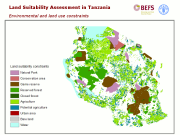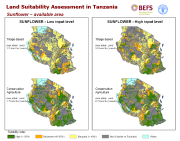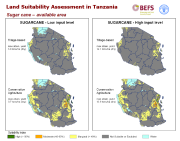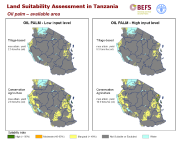bioenergy production
Type of resources
Available actions
Topics
Keywords
Contact for the resource
Provided by
Representation types
Update frequencies
status
-

This map identifies areas that in Tanzania could not be available for bioenergy activities due to diverse constraints. In particular it shows the land already under agriculture production, protected or environmentally sensitive areas, urban settlements and bare land that have been excluded from the BEFS land suitability assessment of Tanzania, in order to get a true understanding of which lands are available for bioenergy production in this country. Data sources: FAO Africover (1995-2002), UNEP-WCMC and IUCN, 2008. All BEFS results have been reported in the FAO publication "Bioenergy and Food Security - The BEFS Analysis for Tanzania" and the final products made available in this catalogue.
-

This dataset presents the result of the Bioenergy and Food Security (BEFS) analysis for Tanzania on land suitability and availability for sunflower. In particular it reports the available area suitable for sunflower production at different levels of suitability, considering specific production systems and level of inputs. Land already under agriculture production or protected or environmentally sensitive has been excluded from the land suitability total area, in order to get a true understanding of which lands are available for bioenergy production in this country. Please note that the "Excluded areas" layers, used to identify areas that in Tanzania could not be available for bioenergy activities, are also described in this catalogue. You may find the link to them in the Distribution Information section of this metadata. The land suitability index categorizes the capability of a specific location to achieve the maximum attainable yield in percentage terms. The maximum attainable yield is defined as the harvested yield of a high-producing variety with “constraint-free†conditions (water, nutrients and pests and disease), which can be achieved under a specific production system and level of inputs. This dataset shows the result of the assessment carried out for the sunflower under two production systems, namely Tillage-based (TA) and Conservation agriculture (CA) and under low and high inputs. The two production systems and two input levels result in four agricultural configurations: 1 - Tillage-based at low inputs (TA-L) 2 - Tillage-based at high inputs (TA-H) 3 - Conservation agriculture at low inputs (CA-L) 4 - Conservation agriculture at high inputs (CA-H) The BEFS analysis has also investigated the following crops for potential bioenergy development: cassava, palm oil, sweet sorghum and sugarcane. All BEFS results have been reported in the FAO publication “Bioenergy and Food Security - The BEFS Analysis for Tanzania†and the final products made available in this catalogue.
-

This dataset presents the result of the Bioenergy and Food Security (BEFS) analysis for Tanzania on land suitability and availability for sugarcane. In particular it reports the available area suitable for sugarcane production at different levels of suitability, considering specific production systems and level of inputs. Land already under agriculture production or protected or environmentally sensitive has been excluded from the land suitability total area, in order to get a true understanding of which lands are available for bioenergy production in this country. Please note that the "Excluded areas" layers, used to identify areas that in Tanzania could not be available for bioenergy activities, are also described in this catalogue. You may find the link to them in the Distribution Information section of this metadata. The land suitability index categorizes the capability of a specific location to achieve the maximum attainable yield in percentage terms. The maximum attainable yield is defined as the harvested yield of a high-producing variety with “constraint-free†conditions (water, nutrients and pests and disease), which can be achieved under a specific production system and level of inputs. This dataset shows the result of the assessment carried out for the sugarcane under two production systems, namely Tillage-based (TA) and Conservation agriculture (CA) and under low and high inputs. The two production systems and two input levels result in four agricultural configurations: 1 - Tillage-based at low inputs (TA-L) 2 - Tillage-based at high inputs (TA-H) 3 - Conservation agriculture at low inputs (CA-L) 4 - Conservation agriculture at high inputs (CA-H) The BEFS analysis has also investigated the following crops for potential bioenergy development: cassava, palm oil, sweet sorghum and sunflower. All BEFS results have been reported in the FAO publication “Bioenergy and Food Security - The BEFS Analysis for Tanzania†and the final products made available in this catalogue.
-

This dataset presents the result of the Bioenergy and Food Security (BEFS) analysis for Tanzania on land suitability and availability for oil palm. In particular it reports the available area suitable for oil palm production at different levels of suitability, considering specific production systems and level of inputs. Land already under agriculture production or protected or environmentally sensitive has been excluded from the land suitability total area, in order to get a true understanding of which lands are available for bioenergy production in this country. Please note that the "Excluded areas" layers, used to identify areas that in Tanzania could not be available for bioenergy activities, are also described in this catalogue. You may find the link to them in the Distribution Information section of this metadata. The land suitability index categorizes the capability of a specific location to achieve the maximum attainable yield in percentage terms. The maximum attainable yield is defined as the harvested yield of a high-producing variety with “constraint-free†conditions (water, nutrients and pests and disease), which can be achieved under a specific production system and level of inputs. This dataset shows the result of the assessment carried out for the oil palm under two production systems, namely Tillage-based (TA) and Conservation agriculture (CA) and under low and high inputs. The two production systems and two input levels result in four agricultural configurations: 1 - Tillage-based at low inputs (TA-L) 2 - Tillage-based at high inputs (TA-H) 3 - Conservation agriculture at low inputs (CA-L) 4 - Conservation agriculture at high inputs (CA-H) The BEFS analysis has also investigated the following crops for potential bioenergy development: sugarcane, cassava, sweet sorghum and sunflower. All BEFS results have been reported in the FAO publication “Bioenergy and Food Security - The BEFS Analysis for Tanzania†and the final products made available in this catalogue.
 FAO Map Catalog
FAO Map Catalog